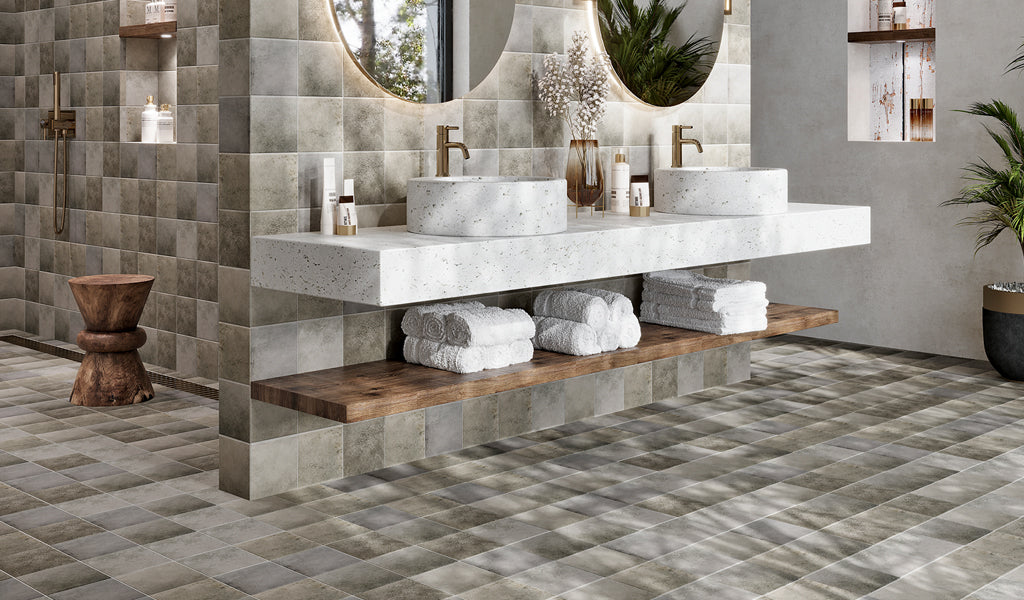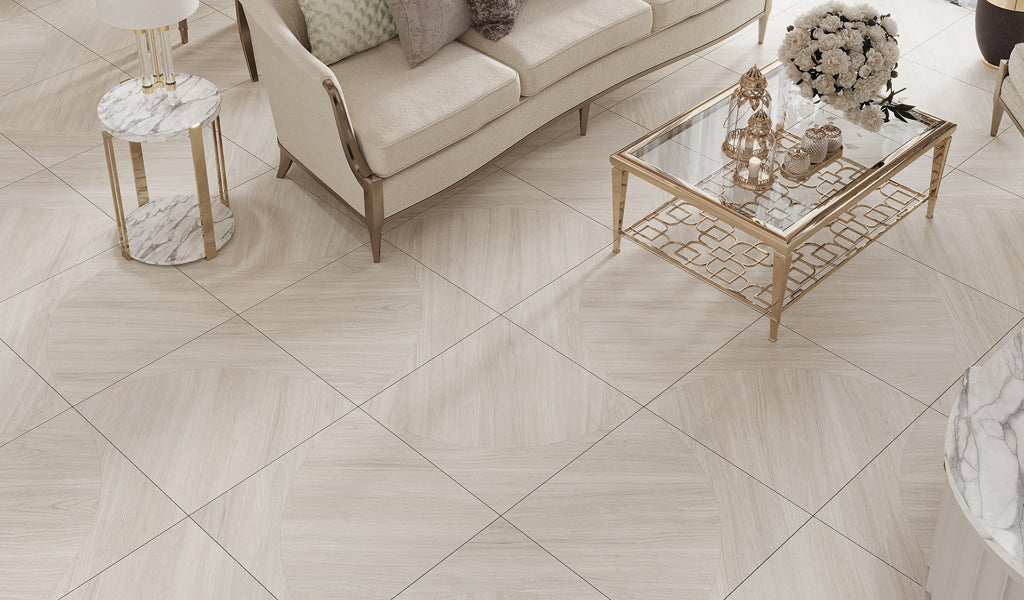How to Regrout Tile: A Step-by-Step Guide for a Fresh, Clean Finish
Aug 04, 2025
Grout can accumulate stains, become discolored, and look dingy over time, detracting from the appeal of the overall tilework. Regrouting is a practical task any DIYer can do to revitalize their tiles without the need for a full replacement. If you’re wondering how to regrout tile, you’re in the right place! Whether working on a shower wall, kitchen backsplash, or floor tile, as long as the tile is in good shape, applying new grout ultimately gives surfaces a new lease on life. This guide walks you through the process and explores everything you need to know to get started.
When Should You Regrout Your Tiles?
When learning how to regrout tile, it’s important to understand when to do so. High moisture areas like bathrooms and showers are more susceptible to grout damage and should be inspected regularly. Spotting the early signs of deterioration is key to maintaining the beauty and integrity of your tiles. Below are a few signs to look out for:
1. Cracked or Missing Grout: Spotting cracks or missing pieces is an indication that the grout has begun to deteriorate. Ignoring this can cause moisture seepage and damage to the tiles beneath.
2. Stained or Discolored Grout: When cleaning simply doesn’t cut it and grout lines remain stained and discolored, regrouting tile floor or wall is a good option to restore the original look.
3. Mold or Mildew Buildup: The growth of mold and mildew is more than an aesthetic issue. If you notice that the issue persists even after cleaning, this can only mean that the mold has taken root in the grout itself. New grout with a quality sealant is an effective solution to restore a hygienic and healthier environment.
4. Crumbling or Powdery Grout: When grout starts to crumble and feel powdery to the touch, it can really hurt the tile's strength. This damage often occurs due to moisture, harsh cleaning chemicals, or aging. If left unaddressed, it can lock moisture in and cause tiles to loosen.
5. Loose or Shifting Tiles: As grout starts to weaken, it loses its ability to hold tiles firmly in place. This results in tiles shifting when you press on them. While this may be an adhesive issue, regrouting tile is the first step in restoring stability.
Tools and Materials for Regrouting Tile
The process of regrouting bathroom tiles or any other tiled area in the home begins by gathering all the necessary tools and materials. Here’s what you’ll need to make regrouting as efficient and painless as possible:
Equipment/Tools
-
- Grout removal tool (manual grout saw or oscillating multi-tool)
- Vacuum or brush (for dust removal)
- Trowel or small putty knife (optional for tight spaces)
- Protective gear: gloves, goggles, and a dust mask
-
- Drop cloth or plastic sheeting
- Rubber grout float
- Mixing bucket
- Drill with mixing paddle
- Grouting sponges
- Microfiber cloth
Materials
-
- Powdered or premixed grout
- Grout haze remover (optional)
- Grout penetrating sealer
Step by Step: How to Regrout Tile Using Traditional Method
1. Prepare the Area: First things first, clear the area and move items away from the tiled surface. Place a drop cloth over nearby fixtures and fittings to prevent stains from grout as it falls. Make sure to have protective gear in hand before starting the removal process.
2. Remove the Old Grout: The most cost-effective way is to use a grout rake or oscillating tool. Guide the tool between the tiles to extract the grout (at least 2–3 mm deep) for the new layer to settle in. Work slowly to avoid chipping the edges or scratching the tile surface. Be thorough, use a vacuum as you go to clear away dust and loose debris that remains.
3. Prepare the New Grout: In a clean bucket, mix the grout to a smooth, peanut butter-like consistency. Prepare only what you will be able to use within about 30 minutes so it doesn’t dry out mid-project. Let the mixture sit (or "slake") for 2-3 minutes and then remix slowly for 30 seconds. As an alternative, you can buy ready-to-use grout.
4. Apply the Grout: The next step is to fill the clean tile joints with grout. Use a rubber grout float to spread it diagonally across the tiles, pressing it into the joints for full coverage. Work in small sections for better control until all the gaps are filled. When you are finished, allow 10-15 minutes for the grout to start setting, then wipe excess from the tile surface before it hardens. Make sure to rinse the sponge as you repeat the process. Be careful not to pull grout out of the seams during this step.
5. Remove Grout Haze: A powdery residue known as haze will appear as new grout begins to set (usually after a couple of hours). Use a soft cloth to buff the tile surface. If necessary, use a haze-removing product to make this step go more quickly.
6. Allow Grout to Cure & Seal: Once you’ve completed grouting, give it 24 to 48 hours to dry. Keep the area free from foot traffic or water during this time. Lastly, seal the tile joints to repel moisture and stains and extend the lifespan of your new grout.
How to Regrout Tile Without Removing Old Grout
If the existing grout is still firmly in place but looks worn, grungy, or has minor cracks, you can apply new grout over the old layer using a process referred to as "grout renewal”. This method is ideal for cosmetic touch-ups and is not recommended for severely damaged and deteriorating grout. The flooring steps are for how to regrout tile without removing old grout:
1. Clean the grout lines: Inspect the grout lines to identify areas that need the most attention. To effectively clean dirt and stains, use a solution of warm water and mild detergent. Allow the grout to dry before moving on to the next step.
2. Roughen the Surface: Take a moment to lightly roughen the old grout with sandpaper and create a bit of depth in the seams to accommodate the new layer. This step forms a textured surface that improves bonding even as grout sits between the tile joints.
3. Apply New Grout: For this step, it’s recommended to use the same type of grout to ensure a consistent finish. To regrout tile floor or wall surface, use a small trowel and press the new grout into the tile joints.
4. Wipe Off Excess Grout: Wait about 10–15 minutes for the grout to slightly dry, then remove excess from the tile surface with a damp sponge. Rinse the sponge and do this a few times without pulling grout from the joints.
5. Let Grout Dry, Then Seal: Next, allow 24-48 hours for the grout to cure. Keep the area dry to ensure proper bonding. As a final step, apply a sealer to protect against moisture, stains, and mold. Learn more from our blog: How to Seal Grout on Tile Floor.
Common Mistakes to Avoid When Regrouting Tile
Mistakes during regrouting can undermine the appearance and longevity of your tile project, making your hard work go to waste. Common missteps include skipping grout removal, using the wrong grout, and rushing through the process—all of which can lead to weak joints, poor adhesion, and a sloppy finish. These are 6 of the most common mistakes to avoid:
• Skipping Grout Removal: While it may seem an easier way to get the job done, applying new over crumbling or loose grout leads to poor adhesion and a short-lived fix. Always remove at least 1/8 inch of the old grout to ensure a solid base for the new layer to adhere to.
• Using the Wrong Grout Type: Another common mistake homeowners make is using the wrong type of grout, such as sanded instead of unsanded. The grout might be too coarse for narrower seams, scratch a delicate tile surface, or fail to fill the joints well. Make sure that the grout used is ideal for your tile spacing and the material installed.
• Improper Mixing of Grout: Grout that’s mixed well has a creamy, smooth consistency. Too much or too little water can render it ineffective and lead to a botched regrouting job. The solution is to pay close attention to the manufacturer’s instructions. Instead of mixing grout by hand, opt for a mixing paddle fastened to an electric drill for the ideal consistency.
• Neglecting to Seal Grout: Sealing is an essential step to prevent moisture, mold, and stains from penetrating and discoloring the grout. Allow grout to fully dry, then apply a penetrating sealer to protect your hard work.
• Rushing the Drying Process: When regrouting floor or wall tile, let the grout fully cure before contact with water or foot activity. Rushing this step can compromise durability and lead to weakened joints prone to cracking. When done properly, a lasting, resilient finish is the result.
• Improper Cleaning After Regrouting: Proper cleaning is essential when learning how to regrout tile. Wiping the tiles too soon or with too much pressure causes grout to dislodge itself from the joints. For the best results, wait until the grout starts to firm up before gently wiping the surface.
Conclusion
Understanding how to regrout tile is a valuable skill that can boost the look and performance of your tiled surface. With the proper tools and some patience, you can achieve a fresh, clean look that rejuvenates your interior without the need to replace tiles entirely. Whether it’s a small project or a larger area, following the proper steps will ensure your installation maintains its integrity for years to come. Ready to give your tiles a fresh start? Grab your grout float and get started—the results are well worth the effort!
Frequently Asked Questions:
1. How do you prevent tile grout deterioration?
Make sure to use quality grout from the outset and apply it properly. Clean dirt and grime regularly with a pH-neutral cleaner and seal grout periodically to repel moisture, mold, and stains.
2. How much does it cost to regrout tile per square foot?
Regrouting tile typically runs between $5 and $30 per square foot or $500 to $2,800 on average for 100 square feet. The final price can vary depending on the size of the job, the condition of the existing grout, and whether you tackle the job yourself or hire an expert.
3. How deep should you remove old grout?
Aim to remove old grout of at least 1/8 inch (3mm) from the seams to give the new grout enough space to adhere properly and last longer.
4. When is the best time to regrout showers and bathrooms?
The ideal time to regrout shower tile is when you spot cracks, stains, or mold that cleaning can't remove. These are telltale signs that the grout has deteriorated and needs to be replaced.
5. How long does it take to regrout tile?
The regrouting process can take a few hours to a full day, depending on the size of the area and the detail involved. A waiting period is required for drying and sealing, so it may take 2–3 days from start to finish.
6. How often should you seal grout?
Grout lines typically need sealing every 6 to 12 months. In high-moisture areas, such as when regrouting bathroom tiles, frequent sealing is necessary to protect against water and stains.
7. How long should you let grout dry before sealing?
Allow 24-48 hours drying time so the sealer can be absorbed effectively for maximum protection.











